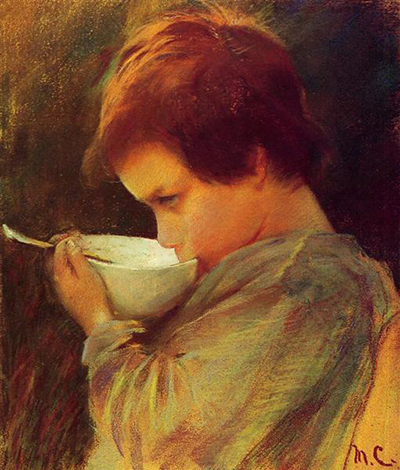This pastel work is dated at 1868, meaning Mary Cassatt would have been in her early to mid twenties at the time. It is therefore one of her earliest pieces and provides an important insight into this part of her career.
The young model is dressed in a fairly modest way, with just a simple shirt, suggesting she is not from a particularly wealthy background. The appearance of her with a small bowl, enjoying just a little food adds to this feeling of relative poverty, in comparison to the later portraits produced by Mary Cassatt. The artist herself was from a very high status background and she liked to help those less fortunate than herself by using them in her work. She regularly chose blonde or redhead children and they seemed to be her favorites, though early on in her career she would make use of the children of family and friends rather than hiring models privately. It was only later when they all grew up that she was forced to look elsewhere for inspiration. She also just adds her initials to the bottom right, where as later on she would leave a signature that included her full name, perhaps demonstrating a growing confidence in her technical ability and a desire to spread her reputation far and wide.
Cassatt and Degas worked with pastels throughout the 1890s but this artwork shows how the former was already using this medium several decades earlier. It was perhaps the influence of Degas which encouraged her to be bolder with her choices of colour, which then led to brighter artworks which suited the Impressionist movement as well as the content that she normally covered. The simple image of a child drinking milk from a bowl retains a certain level of charm which continues to be popular today, and so it would not be surprising for this artwork to be a popular choice as Cassatt print, with many loving the imagery of young children within art.
The sombre tones and unglamorous clothing will remind some of the work of other French artists, even though their artistic styles were a little more traditional. For example, William-Adolphe Bouguereau was an academic artist who regularly featured young children posing in a similar manner. Examples of that included classic artworks like The Shepherdess, The Elder Sister and The Bohemian. It would be around the 18th and 19th century that some French artists would start to tackle the lives of the working poor for the first time, when previously they had been generally ignored in favour of the rich and famous who offered the artists more glamour and also the potential to appease those in power who might return the favour one day. This was much the case across all of Europe and over time the oeuvre of this region has become far more comprehensive and diverse, reflecting all our lives rather than just a select few.




